Yesterday’s analysis expected for the very short term a little more upwards movement within the consolidation, which is what has happened.
Summary: Minor wave 4 may continue for about two weeks or so and may find next support about 3,037. It may be a choppy overlapping consolidation. Thereafter, the upwards trend may resume. The next target is at 3,302 and then 3,336.
Three large pullbacks or consolidations during the next 1-2 years are expected: for minor wave 4, then intermediate (4), and then primary 4. Prior to each of these large corrections beginning, some weakness may begin to be evident.
The biggest picture, Grand Super Cycle analysis, is here.
Monthly charts were last published here, with video here. There are two further alternate monthly charts here, with video here.
ELLIOTT WAVE COUNTS
The two weekly Elliott wave counts below will be labelled First and Second. They may be about of even probability. When the fifth wave currently unfolding on weekly charts may be complete, then these two wave counts will diverge on the severity of the expected following bear market. To see an illustration of this future divergence monthly charts should be viewed.
FIRST WAVE COUNT
WEEKLY CHART
The basic Elliott wave structure consists of a five wave structure up followed by a three wave structure down (for a bull market). This wave count sees the bull market beginning in March 2009 as an incomplete five wave impulse and now within the last fifth wave, which is labelled cycle wave V. This impulse is best viewed on monthly charts. The weekly chart focusses on the end of it.
Elliott wave is fractal. This fifth wave labelled cycle wave V may end a larger fifth wave labelled Super Cycle wave (V), which may end a larger first wave labelled Grand Super Cycle wave I.
The teal Elliott channel is drawn using Elliott’s first technique about the impulse of Super Cycle wave (V). Draw the first trend line from the end of cycle wave I (off to the left of the chart, the weekly candlestick beginning 30th November 2014) to the end of cycle wave III, then place a parallel copy on the end of cycle wave II. This channel perfectly shows where cycle wave IV ended at support. The strongest portion of cycle wave III, the end of primary wave 3, overshoots the upper edge of the channel. This is a typical look for a third wave and suggests the channel is drawn correctly and the way the impulse is counted is correct.
Within Super Cycle wave (V), cycle wave III is shorter than cycle wave I. A core Elliott wave rule states that a third wave may never be the shortest. For this rule to be met in this instance, cycle wave V may not be longer in length than cycle wave III. This limit is at 3,477.39.
Cycle wave V may subdivide either as an impulse or an ending diagonal. Impulses are much more common. An alternative wave count which considered an ending diagonal has been invalidated. While it is possible a diagonal may become an alternate wave count in coming weeks or months, at this stage the structure does not fit.
At this stage, cycle wave V may take another one to two or so years to complete.
The daily chart below will focus on movement from the end of intermediate wave (1) within primary wave 3.
In historic analysis, two further monthly charts have been published that do not have a limit to upwards movement and are more bullish than this wave count. Members are encouraged to consider those possibilities (links below summary) alongside the wave counts presented on a daily and weekly basis.
Within cycle wave V, primary waves 1 and 2 may be complete. Within primary wave 3, intermediate waves (1) and (2) may be complete. Within the middle of intermediate wave (3), no second wave correction may move beyond its start below 2,855.96.
DAILY CHART
All of primary wave 3, intermediate wave (3) and minor wave 3 may only subdivide as impulses.
Minor wave 3 is now complete. Minor wave 3 shows an increase in momentum beyond minor wave 1; MACD supports this wave count.
Minor wave 2 was a sharp deep pullback, so minor wave 4 may be expected to be a very shallow sideways consolidation to exhibit alternation. Minor wave 2 lasted 2 weeks, so minor wave 4 may be about the same duration to have good proportion.
Minor wave 4 may not move into minor wave 1 price territory below 3,021.99.
Intermediate wave (3) must move far enough above the end of intermediate wave (1) to then allow intermediate wave (4) to unfold and remain above intermediate wave (1) price territory. While intermediate wave (3) has now moved beyond the end of intermediate wave (1), meeting a core Elliott wave rule, it still needs to continue higher to give room for intermediate wave (4).
The target for intermediate wave (3) fits with a target calculated for minor wave 3.
Draw an Elliott channel now about intermediate wave (3) using Elliott’s first technique: draw the first trend line from the ends of minor waves 1 to 3, then place a parallel copy on the end of minor wave 2. If it is time consuming enough, then minor wave 4 may find support about the lower edge of this blue channel (although it looks like it may end midway within the channel).
HOURLY CHART
Minor wave 2 was a deep sharp zigzag lasting ten sessions. Given the guideline of alternation, minor wave 4 would least likely subdivide as a zigzag and may more likely subdivide as one of either a triangle, combination or flat correction. Triangles and combinations particularly are usually longer lasting structures than zigzags, so minor wave 4 may last longer than ten sessions.
Minor wave 4 would most likely be shallow. Minor wave 4 may now either move sideways from here, or it may reach lower to the 0.382 Fibonacci ratio.
All of a triangle, combination and flat correction begin with a three wave structure for minute wave a or w. This is almost always a zigzag. Within the first three wave structure, minuette wave (b) may not move beyond the start of minuette wave (a) above 3,154.26.
Minuette wave (b) may be complete with one slight new high tomorrow. Draw a small channel about the zigzag of minuette wave (b). When this channel is breached by downwards movement, that may be an indication that minuette wave (b) may be complete and minuette wave (c) may have begun.
Minuette wave (c) may continue to make a new low in the short term. Thereafter, minute wave b or x may begin. Minute wave b or x may be either a quick sharp bounce, or a time consuming choppy overlapping movement. Minute wave b or x may make a new high above the start of minute wave a or w at 3,154.26 as in an expanded flat, running triangle or part of a combination.
The labelling within minor wave 4 will probably change as it unfolds over the next two weeks or so; alternate wave counts may be required. Focus should not be on identifying exactly which structure it may be and so predicting each small swing within it. Focus should be on identifying when it may be complete. The breakout when minor wave 4 is complete should be upwards; fourth waves are always continuation patterns within the Elliott wave structure one degree higher.
SECOND WAVE COUNT
WEEKLY CHART
This weekly chart is almost identical to the first weekly chart, with the sole exception being the degree of labelling.
This weekly chart moves the degree of labelling for the impulse beginning in March 2009 all down one degree. This difference is best viewed on monthly charts.
The impulse is still viewed as nearing an end; a fifth wave is still seen as needing to complete higher. This wave count labels it primary wave 5.
Primary wave 5 may be subdividing as either an impulse, in the same way that cycle wave V is seen for the first weekly chart.
TECHNICAL ANALYSIS
MONTHLY CHART
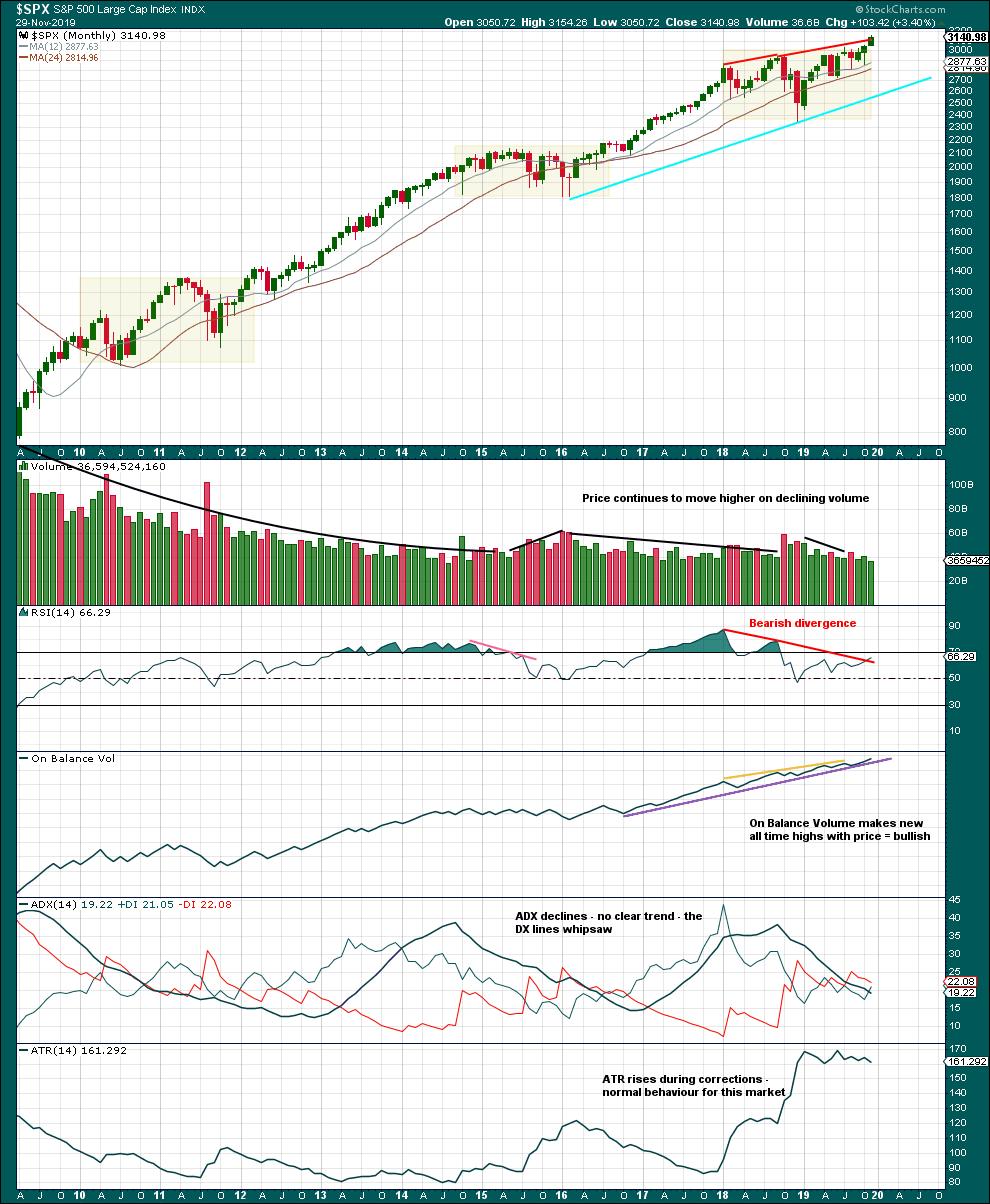
Click chart to enlarge. Chart courtesy of StockCharts.com.
There are three large consolidations noted on this chart, in shaded areas. After a breakout from a multi-month consolidation, it is reasonable to expect a multi month bullish move may result.
This chart very clearly exhibits rising price on declining volume has now persisted for several years. A decline in volume this month, in current market conditions, is not of concern.
On Balance Volume supports the Elliott wave count.
WEEKLY CHART
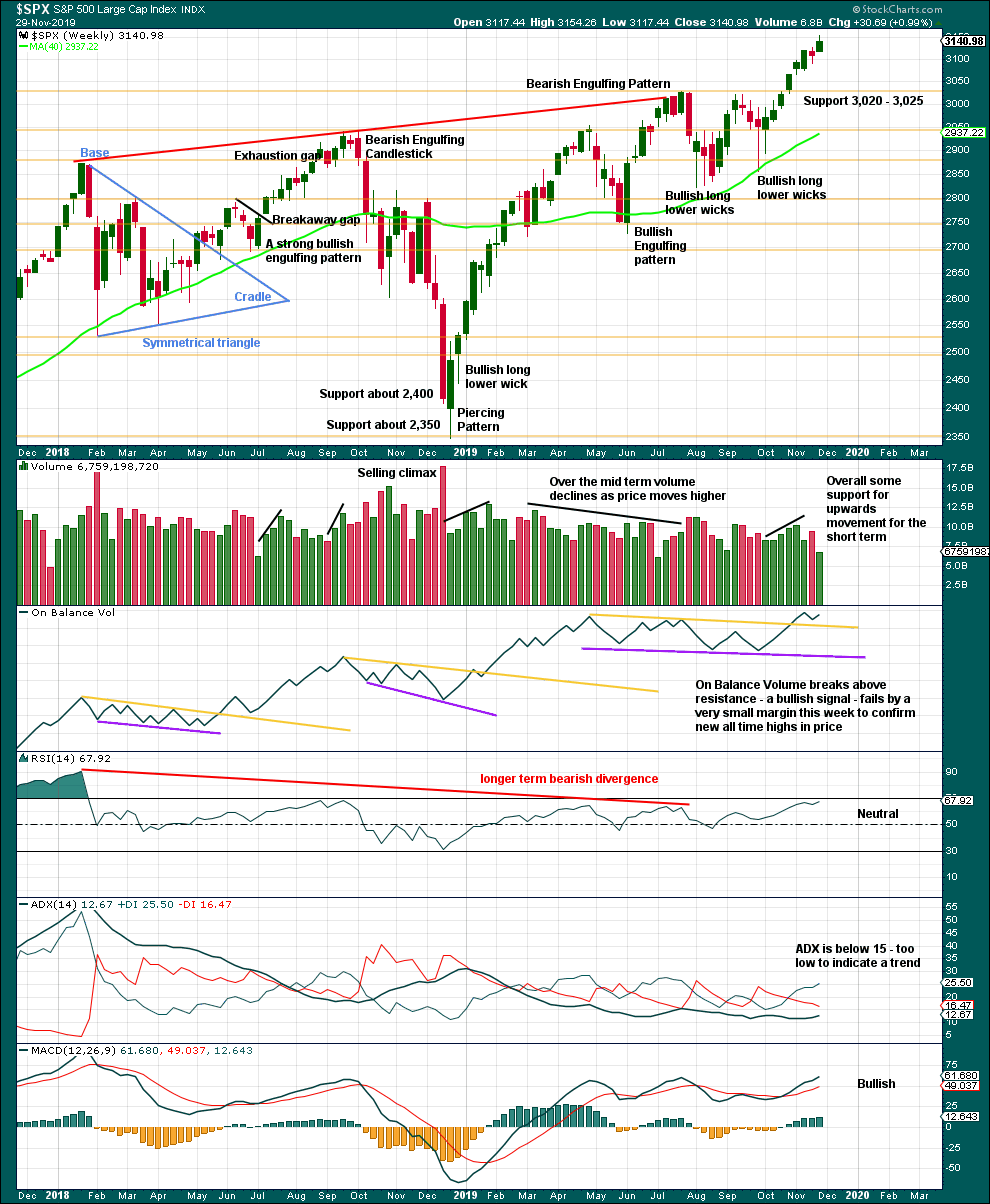
Click chart to enlarge. Chart courtesy of StockCharts.com.
It is very clear that the S&P is in an upwards trend and the bull market is continuing. Price does not move in straight lines; there will be pullbacks and consolidations along the way.
Last week is a short week with New York closed for a day and a half for Thanksgiving Day.
A decline in volume for the last week is acceptable. The failure by On Balance Volume to confirm a new all time high is extremely small, and as this was a short week this shall be given no weight.
Overall, this chart supports the Elliott wave count.
DAILY CHART

Click chart to enlarge. Chart courtesy of StockCharts.com.
There is an upwards trend in place. There will be corrections along the way.
When this market is in a bullish trend, RSI can reach deeply overbought and remain there for some weeks.
The gap downwards has been closed with a new high above 3,110.78. The gap is now a pattern gap.
The long lower wick on today’s candlestick suggests at least a little more upwards movement tomorrow.
This last session is almost evenly balanced between bull and bears, with up/down volume split evenly and advances at 54% of advances/declines. Buying today lacked intensity. This looks like a small range day within a new consolidation.
BREADTH – AD LINE
WEEKLY CHART
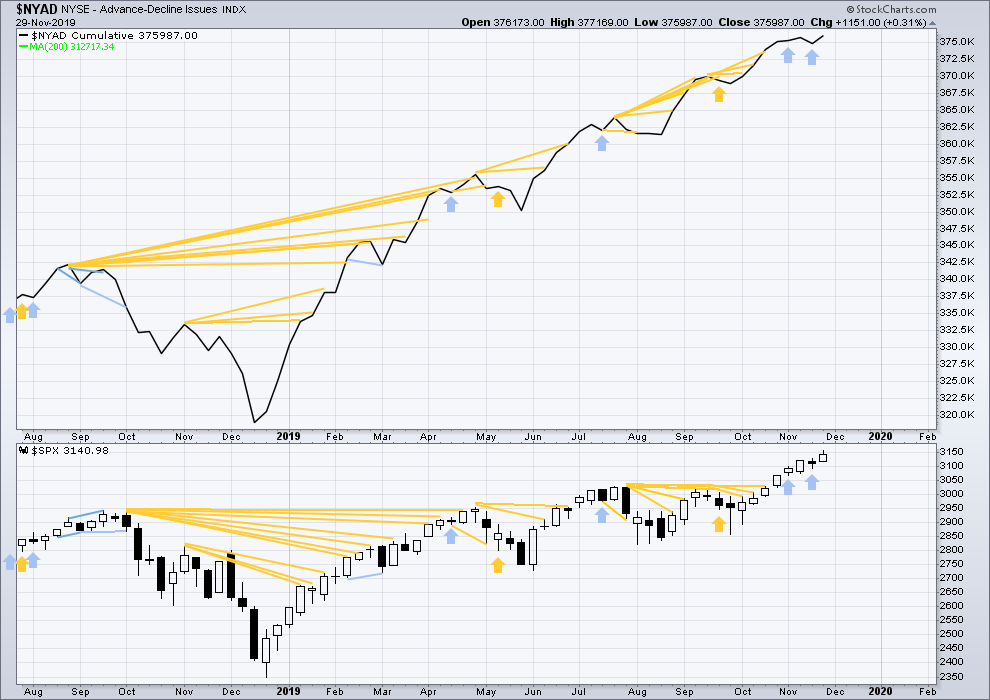
Click chart to enlarge. Chart courtesy of StockCharts.com. So that colour blind members are included, bearish signals
will be noted with blue and bullish signals with yellow.
Bear markets from the Great Depression and onwards have been preceded by an average minimum of 4 months divergence between price and the AD line with only two exceptions in 1946 and 1976. With the AD line making new all time highs last week, the end of this bull market and the start of a new bear market is very likely a minimum of 4 months away, which is mid March 2020.
In all bear markets in the last 90 years there is some positive correlation (0.6022) between the length of bearish divergence and the depth of the following bear market. No to little divergence is correlated with more shallow bear markets. Longer divergence is correlated with deeper bear markets.
If a bear market does develop here, it comes after no bearish divergence. It would therefore more likely be shallow.
All of small, mid and large caps have made new swing highs above the prior swing high on the 13th of September, but only large caps have made new all time highs. This upwards movement appears to be mostly driven by large caps, which is a feature of aged bull markets. This bull market at over 10 years duration certainly fits the definition of aged.
Mid and small caps have not yet made new all time highs.
Last week both price and the AD line have moved higher. Upwards movement this week from price has support from rising market breadth. This is bullish and supports the Elliott wave count.
DAILY CHART
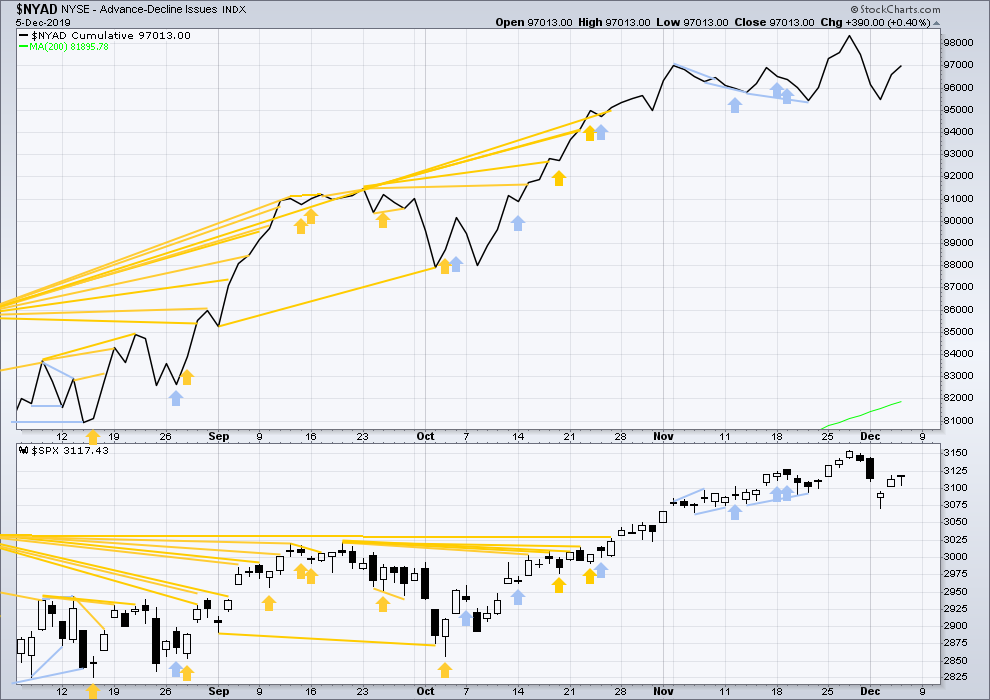
Click chart to enlarge. Chart courtesy of StockCharts.com. So that colour blind members are included, bearish signals
will be noted with blue and bullish signals with yellow.
Breadth should be read as a leading indicator.
Both price and the AD line moved higher again today. Neither have made new highs. There is no new divergence.
VOLATILITY – INVERTED VIX CHART
WEEKLY CHART
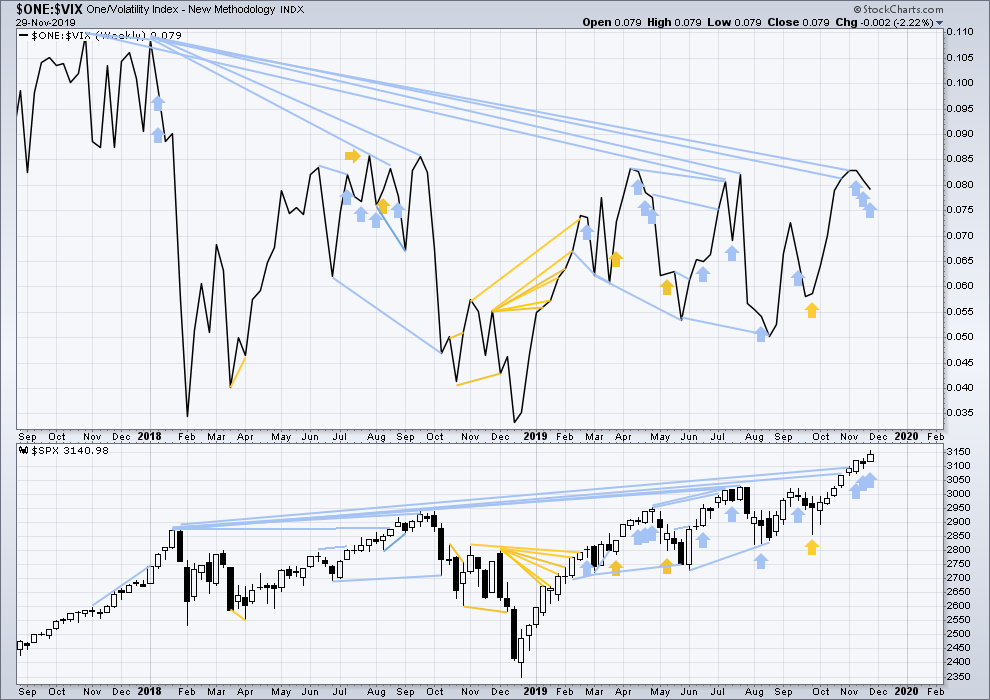
Click chart to enlarge. Chart courtesy of StockCharts.com. So that colour blind members are included, bearish signals
will be noted with blue and bullish signals with yellow.
The all time high for inverted VIX was on 30th October 2017. There is now over two years of bearish divergence between price and inverted VIX.
The rise in price is not coming with a normal corresponding decline in VIX; VIX remains elevated. This long-term divergence is bearish and may yet develop further as the bull market matures.
This divergence may be an early warning, a part of the process of a top developing that may take years. It may is clearly not useful in timing a trend change from bull to a fully fledged bear market.
Price has moved higher for three weeks in a row, but inverted VIX has moved lower. This divergence is now persistent enough to be considered to be sounding a strong warning that there is now reasonable risk to the downside.
The last time this happened was after early January 2018. It was followed by primary wave 4.
DAILY CHART
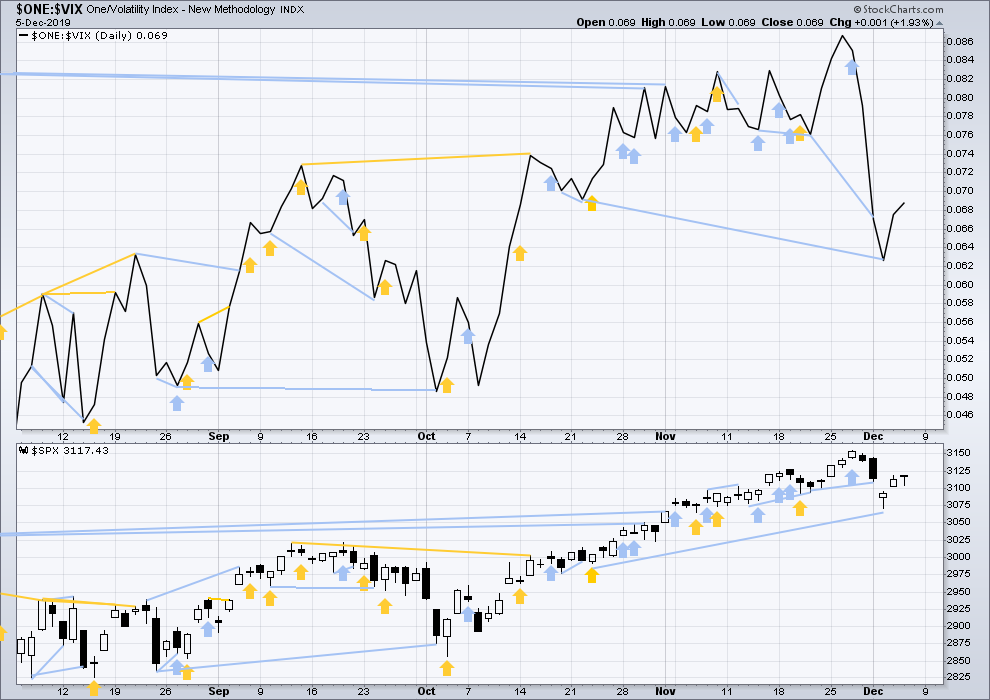
Click chart to enlarge. Chart courtesy of StockCharts.com. So that colour blind members are included, bearish signals
will be noted with blue and bullish signals with yellow.
Both price and inverted VIX have moved higher again today. Neither have made new short-term highs. There is no new short-term divergence.
DOW THEORY
Dow Theory confirmed a bear market in December 2018. This does not necessarily mean a bear market at Grand Super Cycle degree though; Dow Theory makes no comment on Elliott wave counts. On the 25th of August 2015 Dow Theory also confirmed a bear market. The Elliott wave count sees that as part of cycle wave II. After Dow Theory confirmation of a bear market in August 2015, price went on to make new all time highs and the bull market continued.
DJIA: 23,344.52 – a close on the 19th of December at 23,284.97 confirms a bear market.
DJT: 9,806.79 – price has closed below this point on the 13th of December.
S&P500: 2,532.69 – a close on the 19th of December at 2,506.96 provides support to a bear market conclusion.
Nasdaq: 6,630.67 – a close on the 19th of December at 6,618.86 provides support to a bear market conclusion.
With all the indices having moved higher following a Dow Theory bear market confirmation, Dow Theory would confirm a bull market if the following highs are made:
DJIA: 26,951.81 – a close above this point has been made on the 3rd of July 2019.
DJT: 11,623.58 – to date DJT has failed to confirm an ongoing bull market.
S&P500: 2,940.91 – a close above this point was made on the 29th of April 2019.
Nasdaq: 8,133.30 – a close above this point was made on the 26th of April 2019.
Published @ 06:57 p.m. EST.
—
Careful risk management protects your trading account(s).
Follow my two Golden Rules:
1. Always trade with stops.
2. Risk only 1-5% of equity on any one trade.
—
New updates to this analysis are in bold.

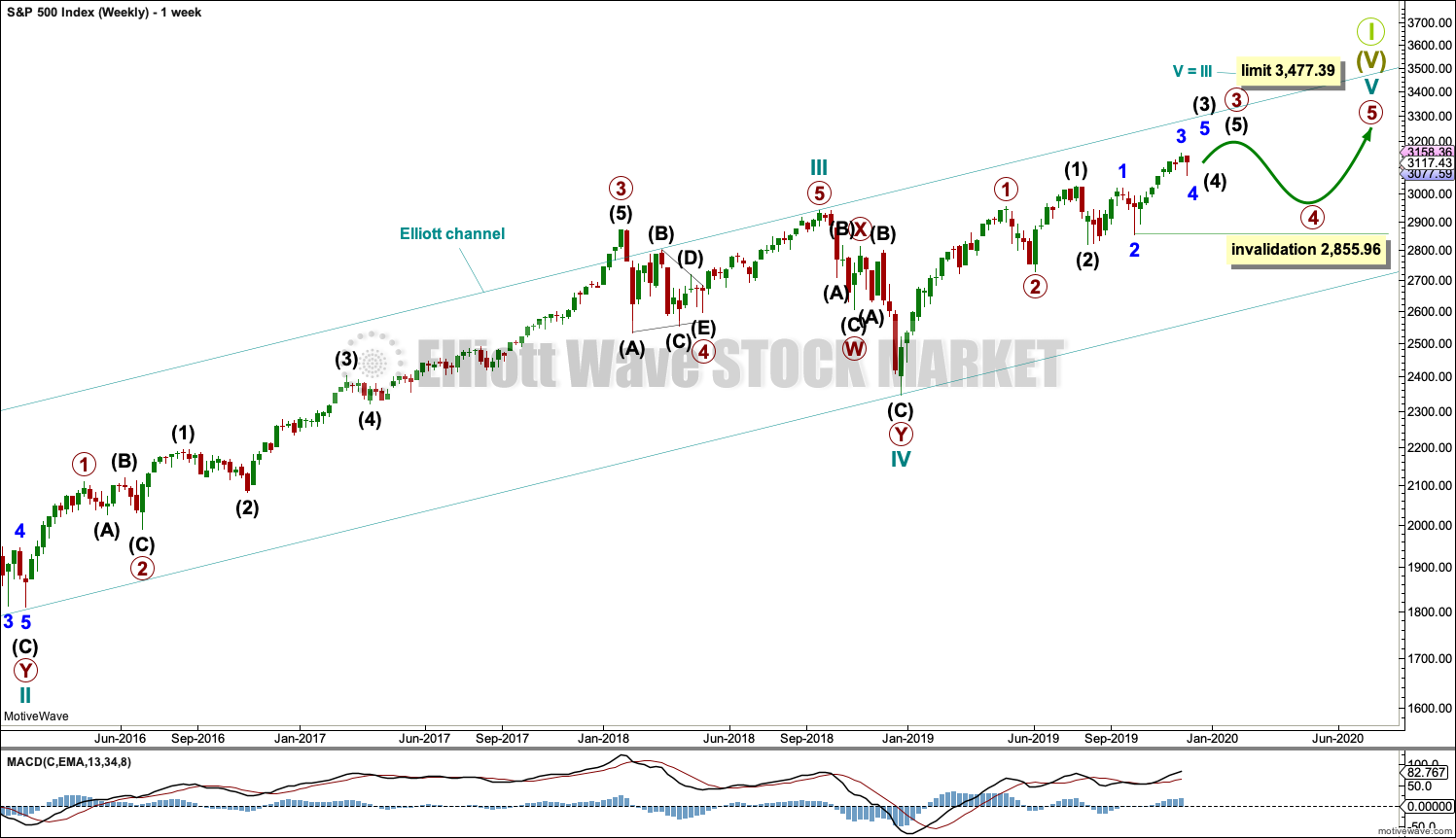
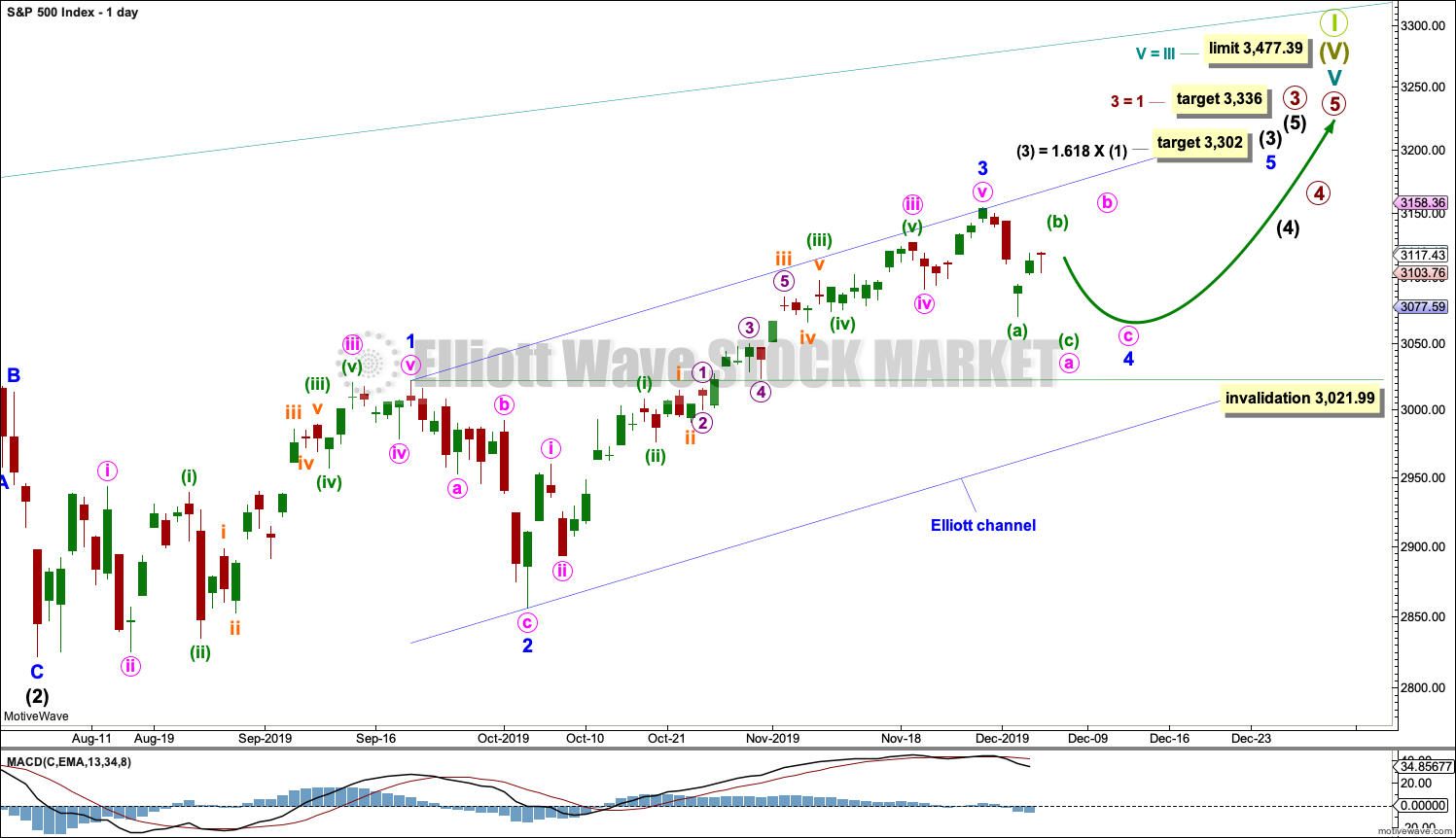
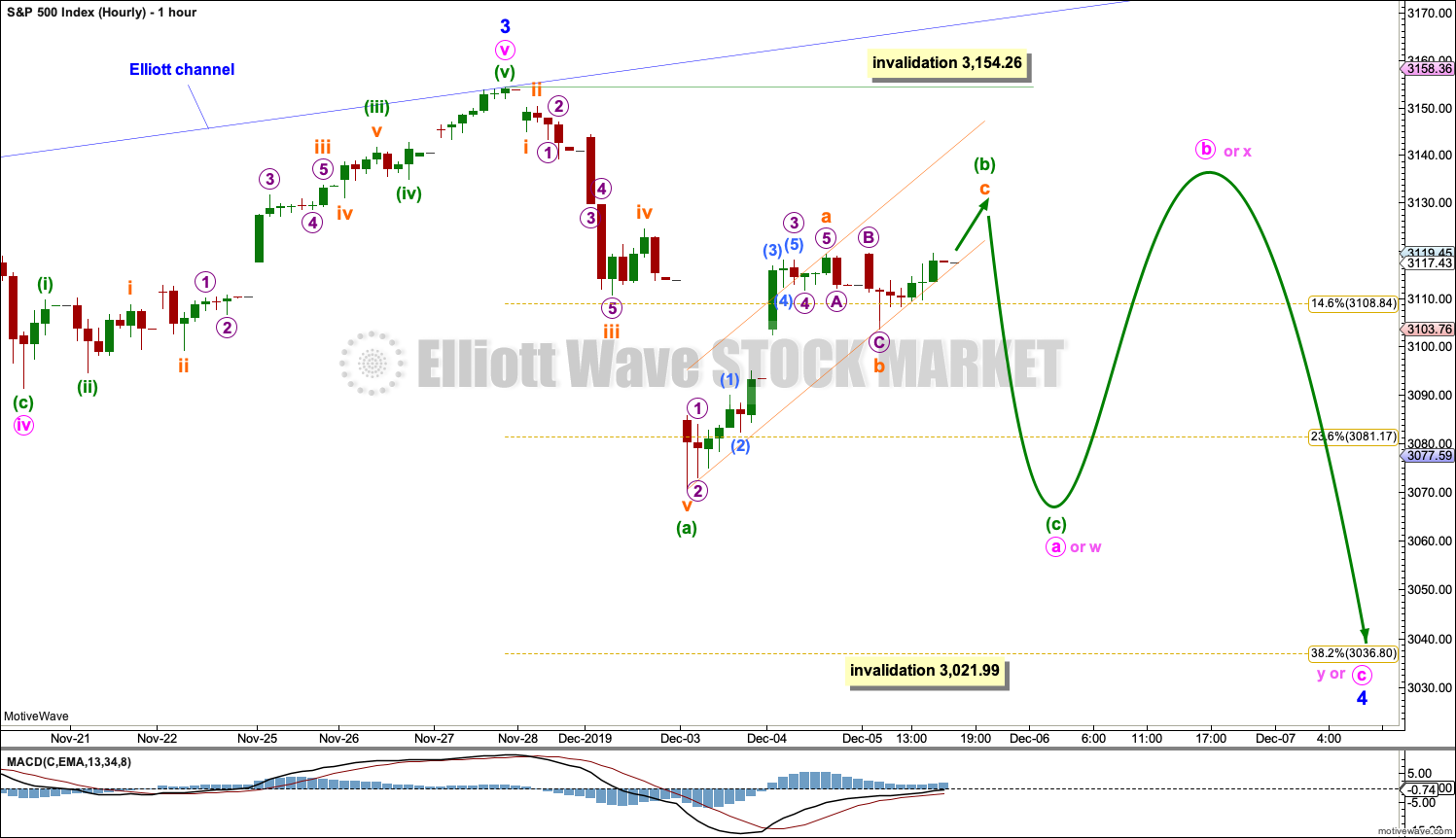
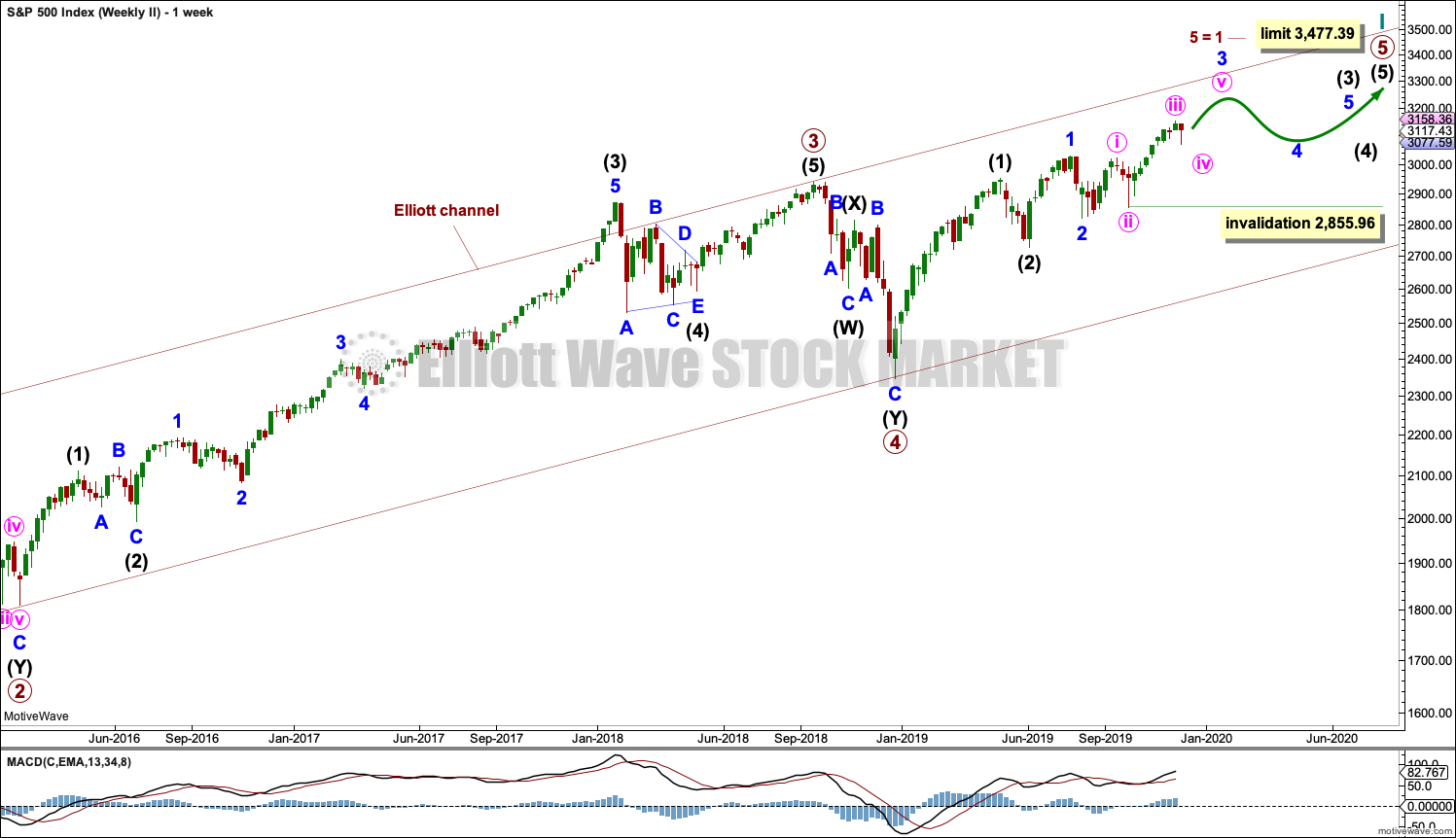
Thanks to everyone for the weeks comments, I really scored on this rocket ride today…. and of course I have to buy a few puts now, I can’t resist
Awesome. I went short Monday, you went long, we both profited! A fine example that volatility enables profitable trading, period.
Good luck with the puts, I’m waiting for short triggers before running the short play again (selling a spy call vertical just over market for expiry next Fri). But I need to see signs of a pivot first.
It seems to me this might be possible. Thus, my reluctance to consider shorting yet.
At this stage, from the top, there was 3 waves down and now 3 waves up. An ABC can easily morph into a 123 so if you see 45, you know this cannot be a B… It could be an A of B, it could be the 1 of a next leg up.
If you choose to play this, stops are easy on the long side (wave 1 or A up, gap, retracement…) But very hard on the short side (basically, a B wave can go almost as high as it wants).
I think it’s very suspicious for the B wave analysis that this morning’s gap wasn’t retraced rapidly..
Hi Arnaud,
could you please explain why breaking 3145 on top will invalidate wave B of minor 4?
Thank you.
Wave B could travel way above ATH and still be a wave B. So if you believe this is part of a big retracement and play short, your stop is not obvious (basically it’s how much pain you can afford being wrong while the market rallies).
When I wrote 45, I didn’t mean 3145… I meant wave 4 and wave 5.
We have seen 3 waves up so far, that some will label ABC and some will label 123. If we see a clean 4 and a clean 5, that would be a 5 wave rally.
Thanks, Arnaud. It makes sense
Do we have to consider the potential that this correction is over, and was in fact the minute iv of the continuing minor 3 up?
In Lara’s analysis minor 4’s B wave can go even higher than high of minor 3 and then back to C wave down. So we might still be in B wave as of now.
To continue as a minor 3 in SPX, a flat or expanding flat structure is now required (or possibly some combination I suppose).
Price is rapidly approaching the underside of the up channel, right where it crosses the ATH level, which is also a key 162% extension of a prior swing. Very high potential for a pivot back down there.
I have considered that and discarded it for now.
Proof that I’m wrong there would come with a gap up to new highs with support from volume.
Kevin,
A concern I would have about your gold count/analysis presented yesterday is that it seems your starting point is September 2018. You really need to start around Dec. 2016 which was the low off the ATH back in September 2011.
If you start at Dec 2016, it is much more difficult to see the current 1-2-3-4 as part of a longer term bullish scenario. I think this is why Lara’s main count has been and continues to favor a longer term bearish count. In addition, Lara has repeatedly stated the US equities and US dollar do not have any meaningful or significant correlation to gold. Hard to believe as I was brought up with a different understanding. But, believe it or not, she demonstrated this with facts from historical analysis.
Well, just my thought on the matter.
Have a great day and weekend everyone.
Thanks Rodney, I’ll look into that. Lara does have what I showed as an alternate in her gold analysis, I’m sure of that. But clearly she considers it lower probability; it’s an alternate. The good news is gold can’t go much longer without giving what should be a strong indication of it’s next swing direction, it’s tightening up between the down trend line and the 38.2% Fibo. I’ll exit my small long if the 38.2% is broken.
Boom!!
Bam!
Blip?